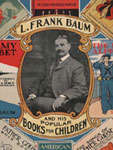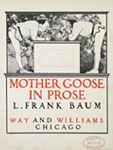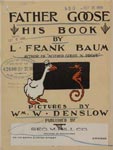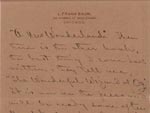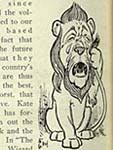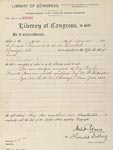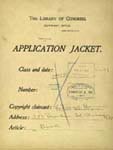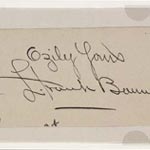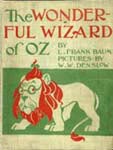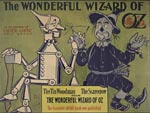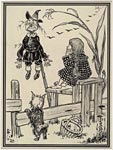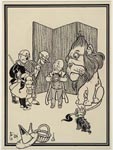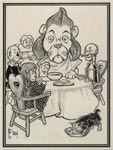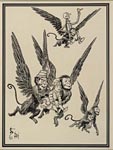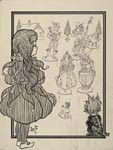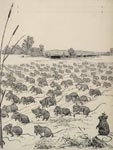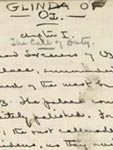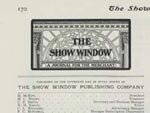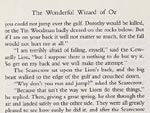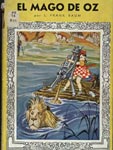
"TO PLEASE A CHILD"
|
||||||||||||||||||||||||||||||||||||||||||||||||||||||||||||||||||||
|
The books were so well loved that Baum's publishers continued the series with other authors to extend the Oz canon to forty books. Although the story seems quintessentially American, the Oz books have become popular world-wide, and the Wizard has been translated into most major languages. |
|
Poster Promoting L. Frank Baum's Early Children's BooksThe Wonderful Wizard of Oz was L. Frank Baum's biggest success, but it was not his first popular book for children. This colorful promotional poster issued by Baum's first publishers shows the author surrounded by the covers of eight of his early books, including The Wonderful Wizard of Oz. |
|
|
|
Book Written and
|
Baum's First Children's BookThis is the first children's book written by Baum and also the first book illustrated by Maxfield Parrish (1870-1966), who became one of America's most popular illustrators. A little farm girl named Dorothy is featured in the last story, and there is some speculation that she is the inspiration for the Dorothy who later became the heroine of Oz. |
|
|
|
Copyright Application for
|
Baum's Letter to His BrotherWith several new children's books forthcoming, L. Frank Baum confided his hopes for them in a lengthy letter to his brother Harry. The displayed page concerns the publication of The Wonderful Wizard of Oz: "Then there is the other book, the best thing I ever have written, they tell me, 'The Wonderful Wizard of Oz'. It is now on the press and will be ready soon after May 1st. Denslow has made profuse illustrations for it and it will glow with bright colors. Mr. Hill, the publisher, says he expects a sale of at least a quarter of a million copies on it. If he is right, that book alone solves my problems." |
|
|
|
Early Review of
|
U. S. Copyright Office Record for The Wonderful Wizard of OzBecause of its role as the nation's copyright depository, collections contain many rare or unique items related to the Wizard of Oz. Through copyright record books like this one, it is possible to trace the career of L. Frank Baum from the 1882 registration for his first play to the 1919 registration of his last book, Glinda of Oz. The Library also has copyright records for the later Oz books, as well as related products. These records and items demonstrate the influence of the Wizard of Oz on American popular culture. |
|
| |
|
Copyright Application for
|
|
|
|
|
|
|
|
| |
|
Advertising Poster for
|
|
| |
|
W. W. Denslow and L. Frank BaumW. W. (William Wallace) Denslow (1856-1915) was a well-known newspaper cartoonist and poster designer when he illustrated Baum's Father Goose, His Book (1899). Following its success, the two men teamed up for Baum's next work, The Wonderful Wizard of Oz. Because Baum and Denslow each thought that his own contribution was the main reason for the success of the book, their relationship deteriorated. Denslow illustrated only one more Baum book, and after he designed costumes for the 1902 stage version of the Wizard his collaboration with Baum ended. He published several children's books of his own, including Denslow's Mother Goose (1901). A stylized hippocampus or seahorse was Denslow's trademark and appears on his artwork. |
|
|
|
|
| |
|
Denslow's Original Artwork for the WizardW. W. Denslow's original artwork consists of black-and-white line drawings, but the illustrations were printed in color. Some appear in full color and others in only one. Each locale of the story has its own color scheme: Kansas is gray; East, blue; West, yellow; South, red; the Emerald City, green; and, the areas between sections, brown. Because their publisher was concerned about the expense of producing the book, Baum and Denslow paid the cost of including the full-color plates. |
|
|
|
|
| |
|
Original Artwork for the WizardW. W. Denslow's vibrant color plates and line drawings for The Wonderful Wizard of Oz helped to make the book an immediate success. An early reviewer of the book praised Denslow's "delightful draughtsmanship." An unusual and innovative feature of The Wonderful Wizard of Oz is the way in which portions of the text were printed over Denslow's drawings, a feature soon copied in other children's books. Most of Denslow's original artwork for the book is now in the collections of The New York Public Library. |
|
|
|
|
| |
|
Manuscript for Baum's Last BookThis is L. Frank Baum's hand-written manuscript for Glinda of Oz, L. his last book. Glinda was Baum's fourteenth book in the Oz series and was published posthumously. The miscellaneous notes and references to earlier books Baum jotted on the binder indicate that he may have used it to hold manuscripts for some of his earlier works. |
|
|
|
|
| |
|
|
|
Baum Becomes a
|
New Edition of
|
|
| |
|
Worldwide Appeal of the Wizard of OzAlthough the story, with its heroine from Kansas and its con man Wizard from Omaha, may seem quintessentially American, the Oz books have become popular worldwide. The Library of Congress collections include editions of the Wizard of Oz in most major languages, including the Spanish, Hebrew, Russian, and Polish editions shown. |
|
|
|
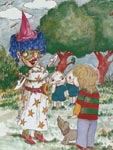 Talma
Alyagon-Roz. Talma
Alyagon-Roz. Ha Kosem M'Erets Uts (The Wizard of Oz). (Adapted from L. Frank Baum. The Wonderful Wizard of Oz.) Illustrated by Yiftah Alon. [Ramat-Gan, Israel], Kineret, 1988. Hebraic Section (25) |
 |
Library of Congress Contact Us (June 30, 2003) |

